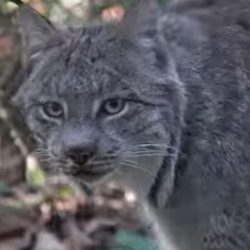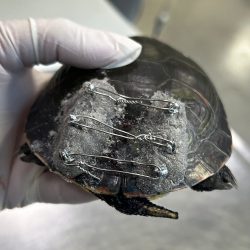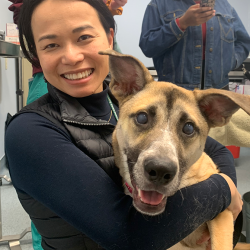Content advisory: This story centers on an animal’s physical recovery after an act of gun violence.

Though many people suggested Huck’s leg could not be saved, Gail Roderick was determined not to give up on her dog.
Roderick had been hiking a familiar trail near Grand Rapids, Michigan when her 2-year-old Australian cattle dog, Huck, was struck in the shoulder by two bullets fired from an unseen hunting rifle some 20 feet away. She rushed him to a local veterinary clinic, where doctors stabilized him, but found that the wounds were too severe for them to repair.
The clinic contacted veterinary orthopedic centers across the state in search of a surgeon who could help Huck.
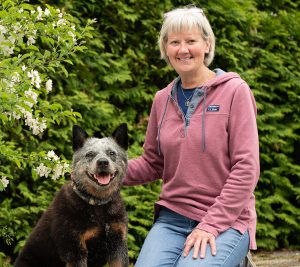
“All but one of them said his leg could not be saved,” says Roderick. “But this was unacceptable. When we called MSU, we talked to Dr. Loïc Déjardin, who said, ‘Please don’t amputate yet. We can fix this.’”
Huck was referred to the Orthopedic Surgery Service at the Michigan State University Veterinary Medical Center, where he fell under the care of Drs. Loïc Déjardin and Danielle Marturello, surgery resident Dr. William Chung, intern Dr. Jory Clark, and clinical DVM student Sofia Perez-Pagan.
MSU-patented Invention Used to Repair Fracture
In surgery, Déjardin placed an I-Loc interlocking nail implant in Huck’s fractured humerus. Developed by Déjardin and patented by MSU, the I-Loc is a thin, metal rod that is placed in the medullar cavity of a bone. Bolts lock the nail into place within the bone, which causes minimal disruption to surrounding soft tissues, allowing patients to heal faster.
This implant also resists fracture forces very effectively, which was critical in Huck’s case, as about 35 percent of his humerus was missing. Such large deficits are called “critical size defects” because they cannot heal on their own. To boost bone healing, Déjardin and his team used a large bone graft as well as antibiotic-impregnated calcium sulfate pellets to control infection.
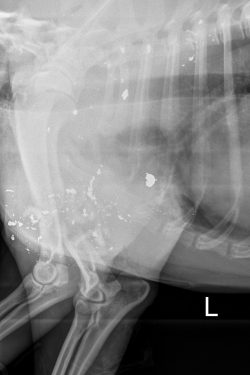
Due to the severity of the fracture and the small size of the lower bone segment, there was very little to anchor the nail to.
“We had to use a smaller-than-optimal nail until the bone formation would allow him to replace the original implant with a larger nail,” explains Déjardin. “We all knew we would be in for the long run, and several surgeries would likely be needed before huck would be fully healed.”
Nonetheless, thanks to Roderick’s unwavering commitment, Huck began his long road to recovery. Six weeks after the initial surgery, Déjardin placed an external skeletal fixator to further support the fracture. Four months after Huck’s injury, when enough bone had formed around the lower bone segment, the fixator and the original nail were replaced with a the larger, initially-planned I-Loc nail. At that time, a second large bone graft and antibiotic pellets were used to optimize bone healing. It took an additional nine weeks for Huck to reach a state that orthopedic surgeons describe as “clinical union,” meaning that the fracture had fully healed. The I-Loc implant was no longer needed.
Déjardin and his team continued to follow Huck’s progress until his humerus had remodeled to resemble the original bone. Full consolidation, also called “boney union,” was documented approximately one year after the original surgery. The long journey of a brave dog and his dedicated humans was reaching a successful conclusion
Roderick hopes for others to be aware that if their animal is seriously wounded, they may have more treatment options than they first realize.
“I am forever indebted to MSU and Dr. Déjardin’s incomparable skill for returning Huck to his joyful, athletic self,” she says.
Grateful for Every Day
At home, Huck was carefully monitored by his family.
“We were so diligent and careful,” describes Roderick. Months of crate rest was no easy feat. As a competitor in show herding events and an avid frolicker on his family’s five-acre farm, Huck led an active lifestyle.
“How do you keep a cattle dog quiet? Firstly, Huck just seemed to get it,” she continues. “Whatever I ask of him, he just seems to understand: ‘This needs to be done,’ and he trusted me.”

Huck also grew to trust the doctors, veterinary nurses, assistants, and clinical students at MSU. Weekly recheck and bandage change appointments meant that Huck came to see campus as a second home. Even today, he lights up when he arrives at the Hospital building.
“He was always happy to see everybody at MSU,” Roderick recalls. “And I could text his doctors any time I thought something was wrong. They always had us in immediately. I felt like there was a huge team as dedicated as I was to saving Huck’s leg.”
Today, Roderick says it’s as if Huck was never injured. He walks several miles a day, plays fetch, and swims and runs at his favorite beach in northern Michigan.
“I don’t take a single day with Huck for granted,” says Roderick. “We end every day with Huck asleep in my lap. Sometimes when Huck is running through the woods full tilt, jumping over logs, turning on a dime, I just watch and lose myself in his revelry. I have my wonderful Huck back and we will make the most of every new day."
A student doctor's perspective:
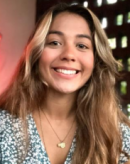
Sofia Perez-Pagan, at the time a clinical DVM student within the Hospital, played a key role in helping Huck to heal, and in turn, developed her capabilities as a veterinarian. She spoke on her time with Huck:
“The client-doctor relationship forms the foundation for achieving remarkable success in veterinary orthopedic surgery recoveries, and Huck's case serves as a shining example. This relationship transcends the mere medical and surgical procedures; it’s rooted in trust, empathy, and effective communication.
The Roderick family became indispensable partners in Huck’s journey to recovery when they placed their trust in the MSU veterinary team, who made them feel heard and valued. This collaboration ensures not only the precise execution of surgical techniques but also a comprehensive approach to post-operative care and rehabilitation. In this cooperative atmosphere, the pet’s well-being takes center stage, resulting in improved post-operative outcomes and an enhanced quality of life for our beloved animals.
Huck’s case was truly exceptional, and my time at MSU will forever be marked by it. Given the complex nature of the case, it demanded significant teamwork, time, and skill. Moreover, establishing a connection with Huck after such a traumatic event was no easy feat. However, little did we know that he would teach us a lesson in resilience. Gaining Huck’s trust was undoubtedly the key to our success. By earning his trust, we were able to help him feel more at ease throughout the intricate recovery process, which involved constant follow-up examinations. This, in turn, enabled us to conduct more detailed examinations, allowing us to detect signs of complications promptly.
Nonetheless, I firmly believe that Huck’s unwavering positive attitude was the cornerstone of his recovery. Even after undergoing such an intricate journey, he never gave up, and never stopped wagging his tail.”

